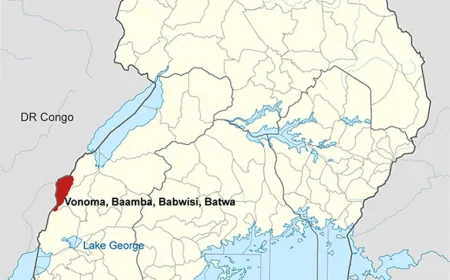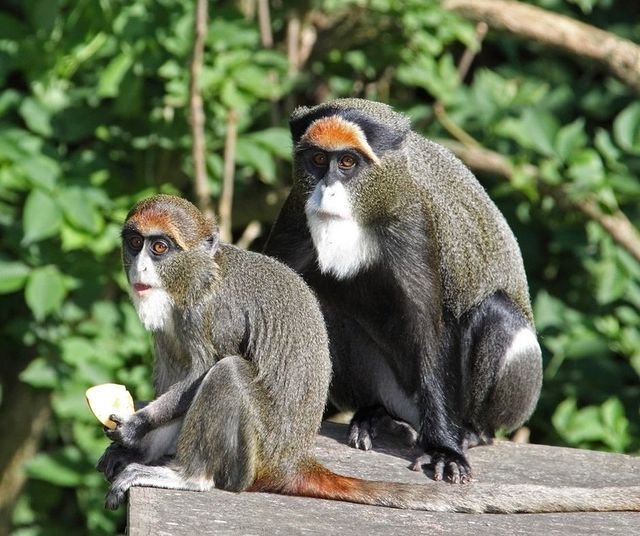Spotted hyena
The most spotted hyenas live in Uganda's Mgahinga National Park's mountainous forest and Queen Elizabeth National Park, Murchison Falls National Park, and Kidepo Valley National Park's prey-rich savanna plains.

The spotted hyena (Crocuta crocuta), also called the laughing hyena, is a hyena species native to sub-Saharan Africa and the only known living member of the genus Crocuta. The IUCN says it is "least concern" because it is common and lives in many places.
In addition to being the largest known member of the Hyaenidae, the spotted hyena can be recognised from other species by its rounder ears, less noticeable mane, spotted pelt, more dual-purposed dentition, fewer nipples, and the existence of a pseudo-penis in females. This species is different from all other mammals because it has a fake penis instead of a real vaginal opening.
The spotted hyena's weaker hindquarters are offset by its powerful neck and forequarters. To avoid being grabbed from behind, the rump is rounded rather than angular. The cranium is big and flat, and the naris is wide. The spotted hyena's ears are more rounded than the pointed ears of the striped hyena. All four toes on each foot are webbed, and the small, thick, and blunt claws are designed for crushing. Wide and flat paw pads are exposed, along with the rest of the foot's underside. The length of the tail is not very long.
The hue of fur can range widely and even alter as animals age. The spotted hyena's fur lacks the well-defined spinal mane of the striped and brown hyenas and is much shorter and more uniformly spotted. An uneven pattern of roundish spots covers the back and hindquarters on top of a pale greyish-brown or yellowish-grey base colour. The patches can range in colour from red to dark brown to nearly black.
Spotted hyenas Behaviour.
Spotted hyenas are extremely sociable creatures that congregate in big groups (called "clans") of up to 80 individuals. Spotted hyena families are tighter-knit and more cohesive than wolf packs, but less so than those of African wild dogs.
Even in situations when lower-ranking females tend to dominate over higher-ranking males, it is still the norm for females to exercise authority over males. Yet, there are instances where women will share authority with a male.
Even in situations when lower-ranking females tend to dominate over higher-ranking males, it is still the norm for females to exercise authority over males. Yet, there are instances where women will share authority with a male.
Even in situations when lower-ranking females tend to dominate over higher-ranking males, it is still the norm for females to exercise authority over males. Yet, there are instances where women will share authority with a male.
Spotted hyenas Reproduction.
There is an increase in births during the rainy season, but the spotted hyena does not have a seasonal breeding pattern. Females have many estrus cycles per month, each of which lasts two weeks. Like many feliform species, the spotted hyena is promiscuous and doesn't stay with the same partner for long. Both sexes may have multiple sexual partners over a period of many years. Even if the male is a lot bigger than the female he wants, he will still act submissive when he gets close to her when she is in heat. Females tend to gravitate toward younger males, whether they were born into the tribe or joined later. A similar preference emerges among females of a certain age, with the added preference that they favour males with whom they have had long and positive relationships in the past. When it comes to wooing women, men who are more laid-back tend to do better than those who are more aggressive.
Spotted hyenas normally only mate at night when there are no other hyenas around, and the entire process takes only 4–12 minutes. To get around the fake scrotum and testes, the male's penis must enter and leave the female's reproductive canal through her fake penis. This makes mating harder. Because of these strange traits, mating is harder for the male than it is for other mammals, and they can't be forced to mate. The upward angle of the penis makes it easier for the male to enter the female once she has retracted her clitoris. After this is done, the characteristic mating stance of mammals is assumed. There can be more than one copulation over the course of a few hours. [53] After mating, it's common for both lovers to lick their genitalia for a while.
The average number of days a woman is pregnant is 110, but this number can vary a lot. Dominant mothers give their females more androgens in the later stages of pregnancy than mothers of lower status do. There are usually two cubs in a litter, but occasionally there can be three. When it comes to child rearing, males simply don't help out. It is challenging for female hyenas to give birth because of their tiny clitoris, and spotted hyena cubs are the heaviest of all carnivoran females. The clitoris ruptures during birth to make way for the baby, and it can take weeks for the wound to heal.
When born, cubs have a weight of about 1.5 kg and a coat of silky, dark brown to black hair. Spotted hyenas are the only carnivorous mammals that are born with their
Locations in Uganda where you can view the spotted hyena.
Queen Elizabeth National Park is the only place in Uganda where you can be sure to see a spotted hyena, though you can also see them in Mgahinga National Park and the other savanna national parks.
Kidepo Valley National Park and its surroundings are also home to the elusive striped hyena (hyaena hyaena) and the insectivorous aardwolf (proteles cristatus), although sightings of either animal are extremely rare.
What's Your Reaction?
 Like
1
Like
1
 Dislike
0
Dislike
0
 Love
1
Love
1
 Funny
0
Funny
0
 Angry
0
Angry
0
 Sad
0
Sad
0
 Wow
0
Wow
0













































































